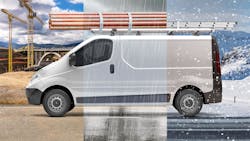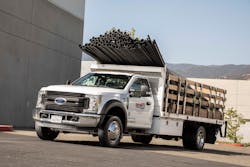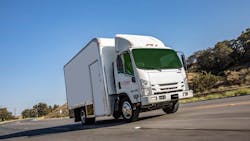Last-mile tire treads: Where the rubber meets the road
The pandemic launched e-commerce and consumers’ digital buying behaviors into overdrive. Data from the U.S. Department of Commerce shows that e-commerce sales have been growing steadily for over a decade, with the most significant growth in the last two years.
In 2021, total U.S. e-commerce sales reached $960.1 billion, an 18.3% year-over-year increase from $811.6 billion in 2020. E-commerce sales in 2021 marked the highest on record and are up from a decade ago, when online sales in 2011 totaled $199.3 billion.
As of late, for the first quarter of 2022, the Census Bureau estimated that U.S. retail e-commerce sales were $250 billion, an increase of 2.4% from the fourth quarter of 2021. E-commerce sales in the first quarter of 2022 accounted for 14.3% of total sales, according to federal data.
See also: Wheel-end monitors: Tech that helps avoid costly ‘thermal events’
These shifts to e-commerce from traditional brick-and-mortar buying behaviors are prompting a booming evolution in fleets’ last-mile delivery (LMD) and regional-haul operations. With that growth comes high commercial equipment utilization rates and demands for new equipment, which have been juxtaposed by lingering OEM backlogs.
“Last-mile delivery and regionalized business has seen continual rise throughout the last decade, with no signs of slowing down, especially as companies meet the demand of their customers for free, fast delivery,” Tom Fanning, Continental Tire’s VP of sales and marketing for truck tires in North America, said.
Because of this explosive growth in the segment, LMD equipment and light commercial vehicles are evolving hand-in-hand, Helmut Lang, head of product management, Truck Tires the Americas, Continental Tire, added.
For the most part, last-mile pickup-and-delivery fleets are spec’ing their tires for cost per mile, overall mileage, durability, and low-rolling resistance, with many fleets moving toward more sustainable tire solutions and practices in today’s world of growing environment, social, and governance standards.
Durable treads
Tire fitments for LMD fleets typically range from 16 inches to 19.5 inches, depending on application. Durability and tread design are among the most important features for tires to withstand LMD, regional, and urban delivery challenges on the road.
Today’s tires have become a mix of complex materials and evolving technology, with tread design playing a major role in functionality. According to Jason Miller, national fleet channel sales manager for Cooper Tire & Rubber Co., last-mile fleets have a blend of consumer and commercial challenges that could be troublesome for tire engineers.
Cooper Tire, which is relatively new to the commercial tire space, was recently acquired by Goodyear. Together, the companies are providing various tire options to the LMD market.
See also: When irregular tire wear talks, fleets need to listen
“The tires for final mile need to have the handling, low road noise, and mileage of consumer tires and the toughness, load flexibility, and casing durability of a commercial truck tire,” Miller said. “All of that comes to play where the rubber literally hits the road—in your tread. Picking the right tire and right tread design will help deliver on the unique needs of final-mile fleets.”
Continental’s LAR3 16-inch tire featuring an all-steel casing has been built for commercial van applications. The all-steel radial was designed for durability and retreadability. According to the company, the tire’s specialized compounding delivers enhanced mileage while providing fuel efficiency. In addition, the 10-ply light truck all-steel casing provides increased load-carrying capacity, durability, and puncture resistance.
In essence, fleets need tread designs with adequate traction to handle all delivery situations—city streets, gravel roads, even steep muddy driveways in some areas—explained Jon Wilkins, Michelin’s senior operational marketing manager.
LMD operations introduce additional stress with the frequency of stops, causing brakes to heat; curbing, or bumping/grinding into curbs, at the delivery point; and the constant twisting and turning to navigate side streets and neighborhood delivery routes.
Spec’ing the right tire and tread design from the start can help fleets get the most from their tires. According to a blog post from tire industry veteran Tim Phillips, VP of marketing and operations for CMA/Double Coin, tire companies and testing agencies are placing considerable resources into testing tires for endurance, curb impact resistance, heat aging, and other factors to determine which tire products can deliver in LMD applications.
Within fleets’ operating areas, tread selection should be based on surface and weather conditions along the routes their equipment and drivers frequent, Tom Clauer, Yokohama Tire’s senior manager of commercial product planning, pointed out.
Fuel economy
Similar to more conventional long-haul operations, last-mile tire tread designs need to address specific operating conditions, Yokohama’s Clauer advised. Typically, shallow rib-type tread designs are the most fuel-efficient, he explained.
“Interestingly, many last-mile deliveries include on-highway and high speeds,” Clauer added. “That alone makes added fuel efficiencies an important factor. Many fleets recognize this and are adding fuel economy components to their equipment as well.”
When possible, operating efficiently also means saving time and money at the pump. That’s where low-rolling-resistance (LRR) features come into play. Overcoming rolling resistance can end up saving up to 33% of a truck’s overall fuel consumption. So, it makes sense that some 80% of new trucks and trailers are spec’ing LRR tires, according to data from the North American Council for Freight Efficiency (NACFE).
Tire makers like Goodyear, for instance, are developing new tires to help fleets meet evolving last-mile expectations. Earlier this year at American Trucking Associations’ Technology & Maintenance Council meeting, Goodyear launched its Fuel Max RSA ULT for regional-haul applications.
See also: With Cooper in the fold, Goodyear says it has a tire for every truck
Goodyear developed its Fuel Max Technology to deliver longer wear, lower cost per mile, and lower rolling resistance for better fuel efficiency. The tire technologies embedded in the Endurance RSA ULT also include: IntelliMax Rib Technology to stiffen tire tread; better rolling resistance; new tread geometry applied to the bottom of the grooves to reduce stress and casing damage; deep, open zig-zag tread pattern with stone-penetration protectors to help enhance traction and resist stone retention on urban streets; and durable casings for retreadability.
“By the time a package reaches your door, the tires have been through a lot,” Goodyear’s Lancy emphasized. “We’ve seen that there is no one-size-fits-all solution. Different tread designs will perform differently in different environments, so it’s important to work closely with a trusted partner to plan and execute the life cycle of your tires.”
When considering the way geography and climate can impact fleet assets, like tires, Keith Iwinski, director of fleet marketing for commercial, Bandag, Bridgestone Americas Tire Operations, explained that fleets running routes in the south would typically seek a straight tread, or ribbed design, for better rolling resistance, longer wear, lateral traction in the rain, and optimal startup traction.
Furthermore, LMD fleets in the northern states may prefer drive tire designs for enhanced traction in the rear axle where LMD fleets in the southern states may only need all-position designs around the whole vehicle, Goodyear’s Lancy added.
Maintain to retread
Although LMD, urban pickup-and-delivery trucks operate mainly in local areas and run short miles compared to long-haul applications, last-mile tires don’t last all that long compared to their over-the-road counterparts. From what Bridgestone’s Iwinski has seen, tires for LMD applications last only about three months. That’s why many fleets are doing what they can to salvage their initial tire casings and capitalize on retreading.
Implementing a maintenance program specifically for last-mile tires that considers the frequent start-stop nature of delivery trucks and vans can also help maximize uptime.
Part of that preventive maintenance means ensuring LMD tires are correctly inflated and regularly rotated. That includes monitoring tire pressure and following manufacturers’ pull-point recommendations.
Typically, the federal commercial tire pull point is 2/32nds. Bridgestone tells its LMD fleet customers that pull points for their operations should be in the 3/32nds and 4/32nds range, so they have the capacity to retread, Iwinski explained.
The key is not allowing the tire casing to become too far worn or for the belt package to become injured beyond repair, otherwise the casing likely won’t be salvageable for retreading, Iwinski advised. Equally important is education on driving conditions—where the vehicle is being operated, how it is being operated, start-and-stop frequency, and debris.
“A lot of times you get punctures on rainy days because water acts as a lubricant, so things that cut tires, cut them easier on rainy days,” Iwinski explained. “Curbing affects casing integrity. So, if you’re pulling up to a house, stay a little bit away from the curb so you can save your tire. When you are backing up, make sure you are not backing up over curbs because of pin shock.”
“It’s OK to walk another 100 feet to deliver the package if you see you are in a construction area,” he added. “That will save your casings in the long run.”
Overall, if the LMD vehicle has a balance or alignment issue, tires are going to wear out much faster.
“When people don’t do pre-trips or post-trips, what ends up happening is that tire injury is an injury on the road,” Iwinski emphasized. “As a last-mile delivery fleet, when that happens, packages have to be loaded onto another vehicle. Now, the fleet is one truck down because the driver didn’t do a pre-trip or a post-trip.”
Technology also has a role to play when it comes to keeping track of tire health. Bridgestone’s IntelliTire solution, for instance, automatically measures and monitors tire pressure and tread depth when vehicles drive over a sensor mat. When vehicles pull into the yard, the onboard system will inform fleets and service dealers when a unit has a flat so the tire can be changed before its next scheduled delivery.
Similarly, Continental’s ContiConnect Yard Reader is a digital tire monitoring solution that can be mounted at a distribution center or fleet terminal to identify any tires with low air pressure or high temperature before they leave. Optimal for vehicles that return to the fleet yard at least once a week, ContiConnect’s web portal displays tire data such as pressure, casing temperature, and valve damage and air leaks to fleet personnel if a problem is detected.
Tires for last-mile EVs
After evaluating data from its Run on Less—Electric program, NACFE determined that half of Class 8 regional-haul tractors are electrifiable today. This is even more apparent in the last-mile delivery market segment, which is typically served by commercial vans and step vans that make it back to their home base each day. In fact, NACFE has reported that LMD vehicles are 100% electrifiable today.
As the last-mile delivery sector continues to adopt electric vehicles (EV), there will be a need for more EV-ready tires.
“Heavier EV vehicles require special consideration to keep them rolling efficiently,” Goodyear’s Lancy pointed out. “Goodyear is seeing a variety of tire sizes being used on these future EV vehicles; some of these commercial fleets may already be using and some new sizes.”
“It’s important that if your fleet is transitioning to EVs that you don’t assume you can use the same tire on ICE and EV vehicles,” Lancy added. “The conditions, environment, and needs of a fleet are all unique and need a tailored approach.”
Goodyear’s first tire developed for commercial EVs is the Endurance RSA ULT and is available in 16 inches, 17.5 inches, and 19.5 inches. The 17.5-inch option has the first Goodyear tire with the company’s Electric Drive Ready badge on the casing wall.
In addition to weight consideration for EV-ready tires, Bridgestone’s Iwinski explained that the high start-stop frequency for last-mile fleets is impactful as well.
“Your moment of inertia is immediate [for EVs] compared to other vehicles,” he said. “You have to think about how that tire immediately starts up.”
LMD EV vehicles need both the durability and longevity in their tire performance as well as low rolling resistance, Michelin’s Wilkins added. And rather than fleets seeking out an EV-specific tire, he believes they should pursue tires with the lowest rolling resistance and longer wear for their electric LMD vehicles.
“There is a trend for some manufacturers to quickly label their tires as 'EV' to capitalize on the current EV change in the industry,” Wilkins advised. “Fleets need real information to understand the components and not be swayed by slick marketing to label a tire EV.”
Continental’s Lang added that in the end, EV-ready tires will have the best rolling resistance to maximize range as well as a higher load index to maximize payload.
Whether they are spec’ing tires for EVs or internal combustion engine vehicles, ultimately, last-mile delivery fleets should evaluate tires based on treadwear longevity, operational durability, and what fits best for their specific operations.
About the Author

Cristina Commendatore
Cristina Commendatore is a past FleetOwner editor-in-chief. She wrote for the publication from 2015 to 2023.





